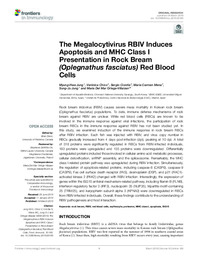Título :
The Megalocytivirus RBIV Induces Apoptosis and MHC Class I Presentation in Rock Bream (Oplegnathus fasciatus) Red Blood Cells |
Autor :
Jung, Myung-Hwa
CHICO GRAS, VERONICA 
Ciordia, Sergio 
Mena, Maria Carmen 
Jung, Sung-Ju 
Ortega-Villaizan, Maria del Mar  |
Editor :
Frontiers Media |
Fecha de publicación:
2019-03 |
URI :
https://hdl.handle.net/11000/34452 |
Resumen :
Rock bream iridovirus (RBIV) causes severe mass mortality in Korean rock bream (Oplegnathus fasciatus) populations. To date, immune defense mechanisms of rock bream against RBIV are unclear. While red blood cells (RBCs) are known to be involved in the immune response against viral infections, the participation of rock bream RBCs in the immune response against RBIV has not been studied yet. In this study, we examined induction of the immune response in rock bream RBCs after RBIV infection. Each fish was injected with RBIV, and virus copy number in RBCs gradually increased from 4 days post-infection (dpi), peaking at 10 dpi. A total of 318 proteins were significantly regulated in RBCs from RBIV-infected individuals, 183 proteins were upregulated and 135 proteins were downregulated. Differentially upregulated proteins included those involved in cellular amino acid metabolic processes, cellular detoxification, snRNP assembly, and the spliceosome. Remarkably, the MHC class I-related protein pathway was upregulated during RBIV infection. Simultaneously, the regulation of apoptosis-related proteins, including caspase-6 (CASP6), caspase-9 (CASP9), Fas cell surface death receptor (FAS), desmoplakin (DSP), and p21 (RAC1)activated kinase 2 (PAK2) changed with RBIV infection. Interestingly, the expression of genes within the ISG15 antiviral mechanism-related pathway, including filamin B (FLNB), interferon regulatory factor 3 (IRF3), nucleoporin 35 (NUP35), tripartite motif-containing 25 (TRIM25), and karyopherin subunit alpha 3 (KPNA3) were downregulated in RBCs from RBIV-infected individuals. Overall, these findings contribute to the understanding of RBIV pathogenesis and host interaction.
|
Palabras clave/Materias:
rock bream
RBIV
red blood cells
erythrocyte
proteome
MHC class I
apoptosis
ISG15 |
Área de conocimiento :
CDU: Ciencias aplicadas: Cuestiones generales de las ciencias aplicadas |
Tipo de documento :
info:eu-repo/semantics/article |
Derechos de acceso:
info:eu-repo/semantics/openAccess |
DOI :
https://doi.org/10.3389/fimmu.2019.00160 |
Publicado en:
Frontiers in Immunology, March 2019 | Volume 10 |
Aparece en las colecciones:
Instituto de Investigación, Desarrollo e Innovación en Biotecnología Sanitaria de Elche
|
 La licencia se describe como: Atribución-NonComercial-NoDerivada 4.0 Internacional.
La licencia se describe como: Atribución-NonComercial-NoDerivada 4.0 Internacional.
.png)
